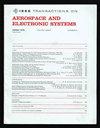基于集群侦察的脉冲雷达信号联合关联、分类与定位
IF 5.7
2区 计算机科学
Q1 ENGINEERING, AEROSPACE
IEEE Transactions on Aerospace and Electronic Systems
Pub Date : 2025-02-18
DOI:10.1109/TAES.2025.3543152
引用次数: 0
摘要
集群协同侦察的一个重要挑战是实现不同侦察单元之间的脉冲关联。然而,传统的到达时间直方图方法在侦察单位距离较远、雷达信号的脉冲重复频率较高或辐射源位置不理想的情况下,难以达到较高的雷达脉冲关联精度。此外,这些方法对TOA直方图的分割很敏感。为了解决这些问题,我们提出了一种用于集群侦察的脉冲关联方法,该方法将雷达信号的关联、分类和定位作为一个统一的问题来处理,旨在集体解决这些问题。此外,我们还引入了模糊生成集的概念来解决定位中的歧义。仿真结果表明,该方法在提高脉冲关联精度的同时,获得了较高的分选精度和定位精度。在TOA误差为50 ns,位置误差为10 m,脉冲下降率为0.2的条件下,该方法对发射源数量的估计精度超过90%,脉冲关联和分类精度大于95%,定位均方根误差小于1%。本文章由计算机程序翻译,如有差异,请以英文原文为准。
Joint Pulse Association, Sorting, and Localization of Pulse Radar Signals With Cluster Reconnaissance
A significant challenge in cluster collaborative reconnaissance is achieving pulse association between disparate reconnaissance units. However, traditional time-of-arrival (TOA) histogram methods struggle to attain high accuracy in radar pulse association when reconnaissance units are distant, the pulse repetition frequency of the radar signal is high, or the emitter's position is suboptimal. Furthermore, these methods are sensitive to the division of the TOA histogram. To address these issues, we propose a pulse association method for cluster reconnaissance that treats the association, sorting, and localization of radar signals as a unified problem, aiming to solve them collectively. In addition, we introduce the concept of a fuzzy generation set to resolve ambiguities in localization. Simulation results demonstrate that our proposed method significantly enhances the accuracy of pulse association while also achieving high sorting accuracy and localization precision. Under conditions with a TOA error of 50 ns, a site error of 10 m, and a pulse drop rate of 0.2, our proposed method achieves an estimation accuracy exceeding 90% for the emitters count, with pulse association and sorting accuracies greater than 95%, and a localization root-mean-square error of less than 1%.
求助全文
通过发布文献求助,成功后即可免费获取论文全文。
去求助
来源期刊
CiteScore
7.80
自引率
13.60%
发文量
433
审稿时长
8.7 months
期刊介绍:
IEEE Transactions on Aerospace and Electronic Systems focuses on the organization, design, development, integration, and operation of complex systems for space, air, ocean, or ground environment. These systems include, but are not limited to, navigation, avionics, spacecraft, aerospace power, radar, sonar, telemetry, defense, transportation, automated testing, and command and control.

 求助内容:
求助内容: 应助结果提醒方式:
应助结果提醒方式:


